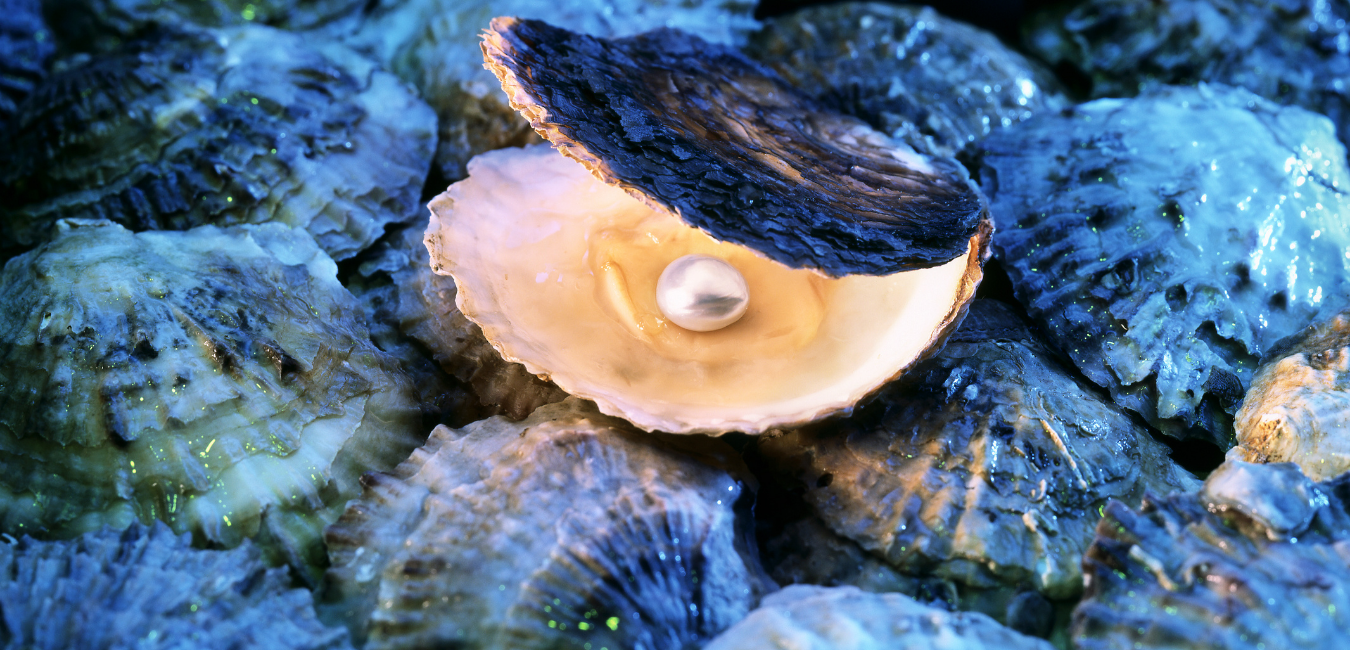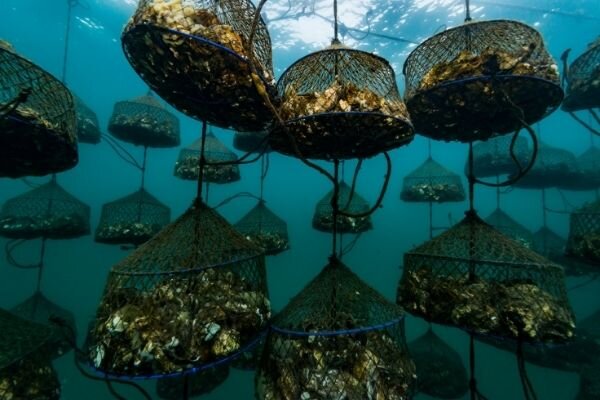
Are Pearls Ethical?
Pearls are one of the most popular gems in the world and are associated with class and elegance. They are used in jewellery, cutlery, furnishings, and cosmetics, but have you ever considered if they are ethical? Let's dive into the facts.
About Oysters
Did you know that molluscs represent the earliest forms of animal life, dating back 550 million years? Molluscs are invertebrates with a soft body often protected by a shell, such as clam, oyster, and mussel [1]. The pearl-producing molluscs first appeared 530 million years ago.
Oysters are sequential hermaphrodites, meaning they regularly change gender several times during their lifetime to regulate the balance in colonies or as a response to water changes.
They are a good indicator of healthy clear water as they will not produce pearls in polluted water. As a result, farms and hatcheries are kept far from other industries.
Pearls are an Oyster's response to pain
Has the wind ever blown grit into your eye? Do you recall how much that hurt and all you did to remove the grit? Multiply that by a hundredfold, as for oysters that pain continues over and over for years.
Pearls are created by oysters trying to get rid of a grit of sand or other material on their organs. They work and struggle to eliminate the pain. They release layers of a crystalline substance called nacre (mother-of-pearl) to coat the grain of sand or a chip from a shell until a pearl is formed [2].
Often too, a sea worm or a bug wriggles into an oyster and causes the oyster to start producing nacre to make the interloper less troublesome, the pearl will grow around the bug as the oyster desperately fights to stop the torment. They produce more and more nacre to try to soften the particle trapped within.
How can Oysters Feel Pain?
Inside the oyster shell are 8 main body parts, a mouth, stomach, heart, intestines, gills, anus, abductor muscle, and mantle. While oysters do not have a brain, like human animals, they do have ganglia, which is their form of brain. It tells their systems to function and respond when they need to, allowing them to respond to their living conditions and survive in them.
“Most, if not all, invertebrates have the capacity to detect and respond to noxious or aversive stimuli. That is, like vertebrates, they are capable of ‘nociception” (Smith 1991). Responses to negative stimuli, such as pain, which is very subjective depending on the individual, can indicate that something more than a simple nociceptive reflex is involved. Together, they may help the animal to recover from damage caused by the painful event and avoid being harmed in the future” (Smith 1991). While invertebrates probably do not feel pain in the same way humans do, Smith stated that the issue isn’t closed. He further stated that, “Mather (1989) suggests, we should simply accept that these animals ‘are different from us, and wait for more data.’ [3]
According to neuroscientist and musician, Brian Manowitz, known as The Vegan Black Metal Chef on YouTube, although bivalves have no central nervous system, they can feel pain. He states: “The bivalves have precursors to a central nervous system. They have nerve ganglia. Even if they are not all connected as a brain, there are little clusters of nerves, which is almost like a pre-brain. We have nerve ganglia too. These are sort of like mini-brains, so our brain doesn’t have to do all the work.”
A research paper from the University of Florida says that generalised molluscs have two paired nerve cords or three in bivalves. Most molluscs have eyes, and all have sensors to detect chemicals, vibrations, and touch. They can, therefore, feel pain.
The Industry
Before the 20th century and for 2,000 years pearl diving was extremely hazardous due to deep water blackouts, drowning and decompression sickness and hyperthermia. Divers were also at risk from attacks by sea creatures and as visibility was often poor divers have died from accidentally picking up a poisonous animal. Divers often had to dive to levels of 30 metres on a single breath, find the oysters and return to air. A pearl diver would be required to do this thirty times a day. Their mortality rate then was 50% [4].
WorkSafe WA Commissioner Lex McCulloch said divers are operating in a hazardous working environment, so require an effective emergency plan to be in place. “Working underwater is a high-risk operation with potentially fatal consequences if anything goes wrong,” Mr McCulloch said. “Employers should have procedures which quickly identify a diver in trouble and facilitate a retrieval of the diver from the water onto the boat.” This followed the death of an experienced diver who worked for a pearl company in W.A.
Natural Pearls
Natural pearls are created without human intervention, however, each and every pearl, whether cultured or natural, represents hundreds and thousands of oyster shells being opened up and discarded, resulting in their death. This is because not all oysters make pearls.
The colour of pearls depends on the colour of the lip of the oyster. Black pearls are considered more valuable because of their rarity and size. They are formed when that piece of irritant gets stuck in the body of a very specific type of oyster, the Tahitian black-lipped Pinctada margaritifera. The interior shell, called the nacre, of most oysters, is usually a glossy white or silver but the Tahitian black-lipped oyster features a thick band of black [5].
Only one in ten thousand oysters produce a pearl. From these, only about 1 in a million are of high quality.
Cultured Pearls (human intervention)
For this reason, people began forcing oysters to make pearls, known as "cultured pearls". This is when a human pry open the shell and surgically implants a foreign item into the oyster's flesh. The oyster recognises it as an irritant and begins to coat it with smooth layers of nacre. It takes at least 6 months for a pearl to be forged, but pearl growers leave oysters for a year and more in the hopes of larger pearls [6]. For however long the vexation endures is the time these animals suffer.
Some pearl “farmers” will remove pearls from an oyster without killing them, keeping them alive to endure repeated insertions of foreign materials to continue making pearls. It is estimated that around a third to half of them are kept while the rest are killed.
Pearl Farms and hatcheries
Cultured pearls are grown on what is known as pearl farms. Several thousand oysters are nucleated and then “cared for” during the 2-5 years required for a pearl to grow and develop.
Pearl Powder used therapeutically and cosmetically
For centuries Chinese women (usually wealthy women) have consumed crushed pearl powder to enhance their skin and that of their children. Historians trace the practice back to more than 1,500 years ago in ancient China. According to Lisa Eldridge's Face Paint: The Story of Makeup, Empress Wu Ze Tian was famed for using pearl powder during the 7th century to achieve her famous complexion. Pearl powder is gaining in popularity in Western countries as a beauty product.
Unsurprisingly, there are those out there making claims their pearl powder is genuine. Some companies are selling a product that has been cleansed with strong corrosive chemicals that are harmful and any resemblance to the pure product is perhaps merely the name.
Cosmetic companies are including pearl powder in deodorants, skin-care products (face masques and foam cleanser), lip balms, and extravagant claims of miracle age-defying creams and potions. Pearl powder is also used as a purported anti-inflammatory and detoxification treatment.
In 2012 Beauty Without Cruelty launched a campaign against the use of pearls, as a result of which ORRA, one of the world’s leading jewellers, agreed not to sell pearls in five of their stores and display a “Pearls = Pain” poster.
Oysters used for food
Approximately 95% of oysters used for food have been farmed and these are not the oysters used to make pearls [7]. What you may not know is that oysters are still alive when you eat them. They are kept on ice before they are "shucked". "Shucking" is when a knife goes through the oyster’s abductor muscle - the muscle they use to open and close their shells - and their body is removed. This is like someone severing our spinal columns, while we are still alive.
Human-made Imitation Pearls
If you are wanting to purchase faux pearls, please be mindful that they still may contain animals or animal by-products. Some common alternatives are made from sand muscles, fish scales (bathed pearl), the protuberance from the mother-of-pearl (known as a bohemian pearl), and other parts of an oyster’s shell [8].
Look for glass pearls and Cotton Pearls (these are totally ethical and made from cotton and mica (mineral dust) and are also known as Utter Ethical Pearls.




